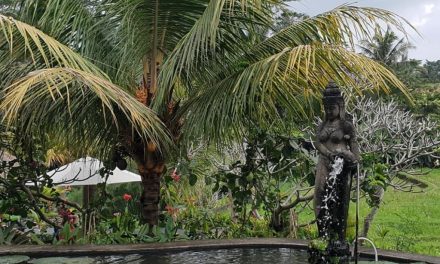Ah, Ubud! Nestled in the lush hills of Bali, it’s not just the artistic heart of the island; it’s a treasure trove of historical attractions waiting to be explored. With its vibrant culture and profound historical roots, Ubud offers visitors a unique glimpse into Bali’s storied past. Having traveled to Ubud multiple times, I can confidently say that these must-see historical attractions are not just sites; they are experiences steeped in rich traditions, captivating stories, and moments that resonate.
Puri Saren Agung (The Ubud Palace)
First on my list is the stunning Puri Saren Agung, or the Ubud Palace. The moment I stepped through its gates, I felt transported back in time. This majestic palace, dating back to the 1800s, serves as a reminder of Ubud’s royal lineage. As I wandered the grounds, I was captivated by the intricate wood carvings and beautifully manicured gardens.
A unique aspect of visiting the palace is that it often hosts traditional dance performances, especially in the evenings. I vividly recall sitting on the stone steps, eating delicious grilled corn from a nearby vendor, as the vibrant colors of the Balinese dances illuminated the courtyard. It was a magical experience that intertwined the site’s history with the living culture of Bali.
Practical Tip:
Make sure to check the schedule for dance performances when you visit, as it provides a wonderful way to experience Balinese culture firsthand.
Goa Gajah (Elephant Cave)
Next up is Goa Gajah, also known as the Elephant Cave. This historical site is a UNESCO World Heritage Site and is believed to have been constructed in the 11th century. The moment I arrived, I was struck by the haunting beauty of the entrance, which features intricate stone carvings of demonic faces.
What I found particularly fascinating was how the cave served not only as a place of meditation but also as a water source. As I explored the caves, I could hear the soothing sounds of running water from the nearby springs, which only added to the serene atmosphere.
I remember sitting quietly inside the cave, taking a moment for reflection and simply soaking in the atmosphere. It’s a great spot to connect with nature and history simultaneously.
Practical Tip:
Bring a sarong and sash, as it’s traditional to dress respectfully while visiting sacred sites in Bali.
Tegalalang Rice Terraces
While technically more of a natural attraction, the Tegalalang Rice Terraces are steeped in history and agricultural significance. When I visited these iconic terraces, I was amazed not just by their beauty but by the brilliance of the subak system—an ancient irrigation practice that dates back centuries.
Walking alongside the terraces, I encountered friendly locals who were harvesting rice. I’ll never forget the joy of joining them for a few moments, learning how to tell the ripeness of the rice and appreciating the hard work that goes into each grain. It’s a humbling reminder of the relationships between people, land, and history.
Practical Tip:
Try to visit early in the morning. The light at sunrise creates a magical atmosphere, perfect for photography and tranquility before the crowds arrive.
Blanco Renaissance Museum
Another gem in Ubud is the Blanco Renaissance Museum, dedicated to the life and work of the late Antonio Blanco, a flamboyant artist who made Bali his home. His eclectic style and vibrant use of color reflect the rich cultural tapestry of Ubud itself.
As I strolled through the museum, I chuckled at some of Blanco’s more whimsical pieces and admired his stunning landscapes. The location itself is perched on a hill, offering incredible views of the surrounding rice fields and river valley — an artist’s paradise!
I distinctly remember gazing over the valley, holding a warm cup of Balinese coffee, and feeling inspired by the beauty surrounding me. The museum is not just a place to see art; it’s a place to feel the creative energy of Ubud.
Practical Tip:
Join a guided tour if you can; the guides often share stories about Blanco’s life that you won’t find in the exhibit descriptions.
Saraswati Temple
Finally, no visit to Ubud would be complete without the serene Saraswati Temple. Dedicated to the goddess of knowledge and arts, this temple is a peaceful oasis filled with lotus ponds and beautiful stone carvings.
During one of my visits, I stumbled upon a small ceremony taking place, and it felt like witnessing a private moment of devotion. The mood was serene, and I remembered how the sweet sound of gamelan music accompanied the gentle flow of the lotus pond.
Saraswati Temple often hosts art workshops, and I decided to take part in one of the traditional painting classes. What a fun way to connect with the local artists and learn about Balinese art practices!
Practical Tip:
Plan your visit in the early afternoon to enjoy the tranquility and perhaps catch a class or event that celebrates Balinese arts.
Conclusion
Ubud is a historical tapestry woven from culture, artistry, and deep spiritual roots. Each attraction tells its own story and beckons you to pause, reflect, and participate in its ongoing narrative. The people I met, the experiences I had, and the lessons I learned have all contributed to my fond memories of this beautiful town.Whether you are stepping into the royal grounds of the Ubud Palace or meditating in the serenity of Goa Gajah, each moment is an opportunity to connect with the past. So, grab your sarong, your sense of adventure, and embark on a journey through the enchanting historical attractions that Ubud has to offer!






